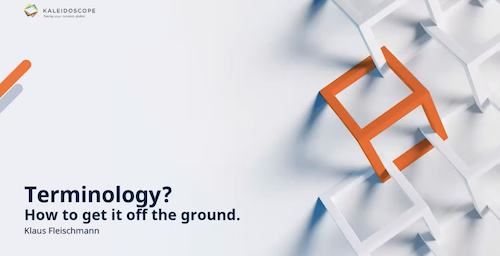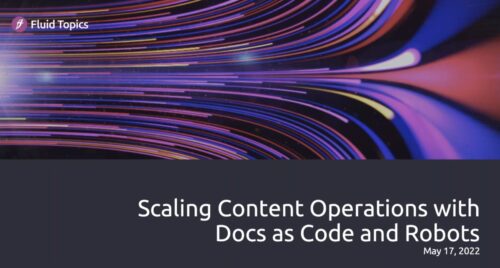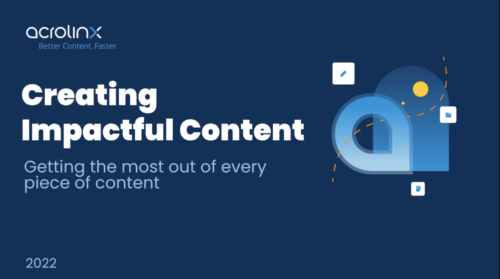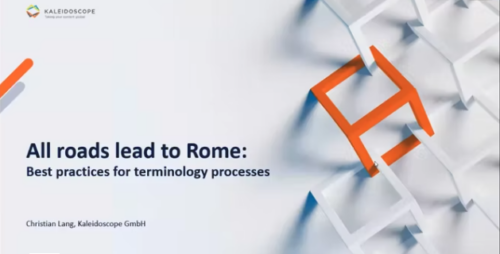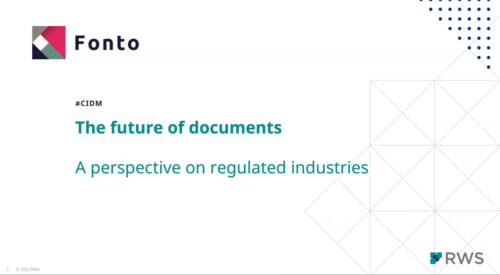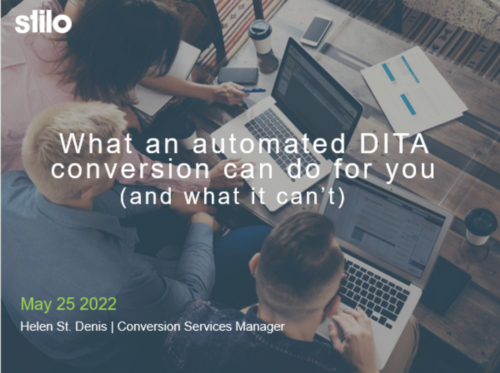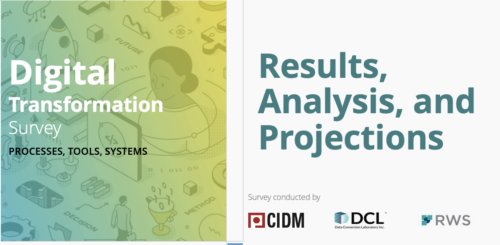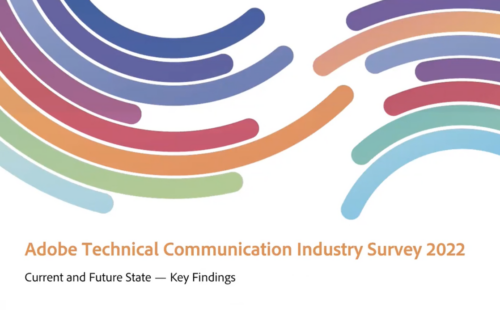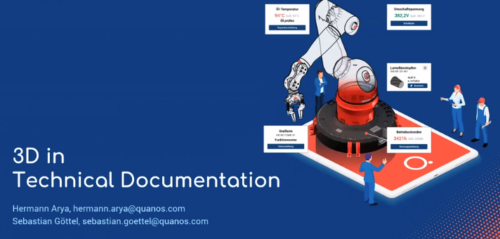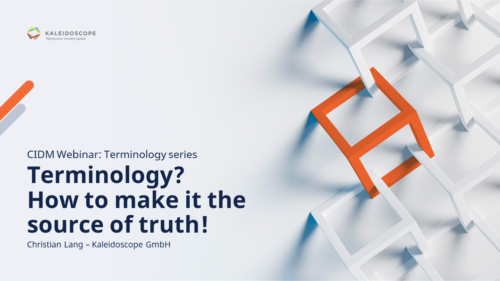-
Recorded: April 20, 2022
 Presented by Géraldine Boulez
Your technical documentation is one of your company’s most valuable assets. The bad news is: your execs and most of the other departments in your organization don’t know about it. Even worse, some even consider tech content as an unproductive cost and try to cut it to a minimum.
Still, your documentation can achieve your company’s most critical goals in all customer-facing areas, and it’s high time your organization understood and embraced the business opportunity brought by tech doc.
In this webinar, you will learn:
Presented by Géraldine Boulez
Your technical documentation is one of your company’s most valuable assets. The bad news is: your execs and most of the other departments in your organization don’t know about it. Even worse, some even consider tech content as an unproductive cost and try to cut it to a minimum.
Still, your documentation can achieve your company’s most critical goals in all customer-facing areas, and it’s high time your organization understood and embraced the business opportunity brought by tech doc.
In this webinar, you will learn:
- How to debunk the most common misconceptions about the business value of tech doc
- How to connect your tech content to your company’s business goals
- and how to demonstrate to your execs how your documentation can effectively generate gains in three main areas of business: Marketing, Customer Support, and Field Services.
Presented by:
Géraldine is passionate about new technologies and their ability to solve people and business problems. This is what has led her to product management, marketing and business development positions in fast-growing tech companies and innovative corporations for over twenty years. Geraldine is VP of Marketing at Fluid Topics, the leading Content Delivery Platform that reinvents how users search, read and interact with technical documentation.
-
Recorded: April 27, 2022
 Presented by Klaus Fleischmann
OK, so we have all understood that terminology is important for content, AI, search engines, consistent naming, etc.
But what do you need to do
Presented by Klaus Fleischmann
OK, so we have all understood that terminology is important for content, AI, search engines, consistent naming, etc.
But what do you need to do
- to launch a professional and scalable terminology process,
- to convince your boss and your peers that your company needs it and
- to get this off the ground quickly and efficiently with the help of modern terminology software?
-
Recorded: May 17, 2022
 While product cycles are getting shorter in all industries, down to daily releases for SaaS vendors, technical documentation teams have to keep up with the pace. Information needs to be written faster and delivered in sync.
Join Fabrice Lacroix, CEO and founder of Fluid Topics, and Gaspard Bébié-Valérian, certified technical writer and functional consultant, as they untangle the complex process of continuous content delivery and unveil new methods and processes to embrace the new landscape of documentation. They will share their insights and experience as they explore the collaborative potential between SMEs and tech writers opened by Docs as Code, examine the tooling behind a continuous documentation flow, and showcase the example of a robot writing release notes.
Presented by Fabrice Lacroix & Gaspard Bébié-Valérian:
Fabrice Lacroix is a serial entrepreneur and a technology pioneer. He has been working for 25 years on the development of innovative solutions around search technology, content enrichment and AI. He is the founder of Fluid Topics, the leading Content Delivery Platform that reinvents how users search, read and interact with technical documentation.
At the crossroads of engineering and social sciences, Gaspard enjoys exploring the breadth of technologies involved in technical documentation, including structured documentation, CCMS, and collaborative paradigms like docs as code. Gaspard works as Functional Consultant at Antidot helping clients get the most out of Fluid Topics.
While product cycles are getting shorter in all industries, down to daily releases for SaaS vendors, technical documentation teams have to keep up with the pace. Information needs to be written faster and delivered in sync.
Join Fabrice Lacroix, CEO and founder of Fluid Topics, and Gaspard Bébié-Valérian, certified technical writer and functional consultant, as they untangle the complex process of continuous content delivery and unveil new methods and processes to embrace the new landscape of documentation. They will share their insights and experience as they explore the collaborative potential between SMEs and tech writers opened by Docs as Code, examine the tooling behind a continuous documentation flow, and showcase the example of a robot writing release notes.
Presented by Fabrice Lacroix & Gaspard Bébié-Valérian:
Fabrice Lacroix is a serial entrepreneur and a technology pioneer. He has been working for 25 years on the development of innovative solutions around search technology, content enrichment and AI. He is the founder of Fluid Topics, the leading Content Delivery Platform that reinvents how users search, read and interact with technical documentation.
At the crossroads of engineering and social sciences, Gaspard enjoys exploring the breadth of technologies involved in technical documentation, including structured documentation, CCMS, and collaborative paradigms like docs as code. Gaspard works as Functional Consultant at Antidot helping clients get the most out of Fluid Topics. -
Recorded: June 8, 2022
 Content fuels your business. It has a purpose and an expected outcome: Deeper engagement. Higher conversions. Fewer support tickets. The list goes on.
But does your content live up to its expectations? And if not, what can you do about it?
Join Chris Willis, Acrolinx CMO, as he explores the importance and value of content impact. You’ll learn:
Content fuels your business. It has a purpose and an expected outcome: Deeper engagement. Higher conversions. Fewer support tickets. The list goes on.
But does your content live up to its expectations? And if not, what can you do about it?
Join Chris Willis, Acrolinx CMO, as he explores the importance and value of content impact. You’ll learn:
- What impactful content looks like and if yours qualifies
- Why content impact outperforms basic quality to deliver better business results
- How technology can help you automate your content improvement
 Christopher P Willis is Acrolinx’s Chief Marketing Officer, responsible for all aspects of the company’s Marketing strategy. Christopher is a specialist in Content Impact, AI, and pipeline management with over 20 years of experience growing companies in the technology sector. Before joining Acrolinx, Christopher held leadership roles in marketing, creative, technical, and business development at companies including Perfecto, Pyxis Mobile, KPMG-CT, ModelGolf, and Cambridge Technology Group. Willis is a recognized thought leader in the areas of AI, DEI and Content Impact, and is active within industry groups dedicated to the growth and health of Marketing Technology and the verticals he serves. Also, this year, Willis received a Top 100 Marketer Award in the 2022 OnCon Icon Awards.
https://www.linkedin.com/in/cpwillis
Christopher P Willis is Acrolinx’s Chief Marketing Officer, responsible for all aspects of the company’s Marketing strategy. Christopher is a specialist in Content Impact, AI, and pipeline management with over 20 years of experience growing companies in the technology sector. Before joining Acrolinx, Christopher held leadership roles in marketing, creative, technical, and business development at companies including Perfecto, Pyxis Mobile, KPMG-CT, ModelGolf, and Cambridge Technology Group. Willis is a recognized thought leader in the areas of AI, DEI and Content Impact, and is active within industry groups dedicated to the growth and health of Marketing Technology and the verticals he serves. Also, this year, Willis received a Top 100 Marketer Award in the 2022 OnCon Icon Awards.
https://www.linkedin.com/in/cpwillis -
Recorded: June 9, 2022
 Terminology only works effectively if the organization manages to agree on consistent concepts and terms. But to achieve a company-wide understanding and agreement a well thought out process and regular interaction are needed. While some organizations prefer a systematic process, others react to ad hoc requests, some are happy with a combination of both.
Therefore, we
Terminology only works effectively if the organization manages to agree on consistent concepts and terms. But to achieve a company-wide understanding and agreement a well thought out process and regular interaction are needed. While some organizations prefer a systematic process, others react to ad hoc requests, some are happy with a combination of both.
Therefore, we
- look at the advantages and disadvantages of both approaches and
- share how to set them up in practice
 Christian Lang, Technical Consultant, has a wide range of experience and interests in the language field, proven by his degree in Japanese studies and translation. He first became involved with terminology management as a freelance translator for the European Patent Office. Since then, it has become one of his hobbies, as has research in the field of NLP on topics such as machine translation, automatic term extraction, and concept maps.
Christian Lang, Technical Consultant, has a wide range of experience and interests in the language field, proven by his degree in Japanese studies and translation. He first became involved with terminology management as a freelance translator for the European Patent Office. Since then, it has become one of his hobbies, as has research in the field of NLP on topics such as machine translation, automatic term extraction, and concept maps.
-
Recorded on June 15, 2022
 The Future of Documents is shaped by a fundamental change in how information is exchanged. This future sees a shift from traditional 'e-paper', formatted and optimized for reading by humans, towards semantically tagged information - exchanged in an open digital format. In this talk, we will share examples from industries that have a history in structured content - such as publishing and technical documentation - as well as from industries that are ‘newer to the game’, such as pharma and financial services.
The Future of Documents is shaped by a fundamental change in how information is exchanged. This future sees a shift from traditional 'e-paper', formatted and optimized for reading by humans, towards semantically tagged information - exchanged in an open digital format. In this talk, we will share examples from industries that have a history in structured content - such as publishing and technical documentation - as well as from industries that are ‘newer to the game’, such as pharma and financial services.
- The Future of documents, - structured content and semantics from niche to mainstream
- Define Structured Content. What is it, and why is it so fundamentally different from formatted documents?
- What drives organizations to move from traditional authoring towards structured content authoring
- How can industries learn from each other? – Discussing benefits and features.
- Content automation
- Documents as data
- Component based authoring
- Future of documents
 Jan Benedictus is Founder and Managing Director of Fonto. His experience goes back to the late 1990's when he started working in the field of online and digital publishing. In 2014, he started Fonto - with the mission to make structured content authoring available for everyone.
Fonto, now part of RWS, is the leading provider of user-friendly tools for structured content creation, editing and review. Jan is a regular speaker on the subject of The Future of Documents; sharing Fonto's experiences and insights from working with structured content in various industries.
Jan Benedictus is Founder and Managing Director of Fonto. His experience goes back to the late 1990's when he started working in the field of online and digital publishing. In 2014, he started Fonto - with the mission to make structured content authoring available for everyone.
Fonto, now part of RWS, is the leading provider of user-friendly tools for structured content creation, editing and review. Jan is a regular speaker on the subject of The Future of Documents; sharing Fonto's experiences and insights from working with structured content in various industries.
-
Recorded: May 25, 2022
 Presented by Helen St. Denis
Pretty easily, we can get a basic DITA structure from headings, tables and lists in the legacy content. As well, though, for each different source format there are a number of ways to extract information that can be used to refine the DITA output. Likewise, there are ways to enrich the content automatically.
There are, however, some things it can’t do… yet.
As more and more types of content are being moved to DITA, a greater variety of legacy formats need to be converted. We’ll look at some of them to see what can be gleaned from each, beyond the basic structure, and some of the challenges that remain.
Presented by: Helen St. Denis
Helen started at Stilo over twenty years ago as a technical editor. As Conversion Services manager, she’s helped customers convert millions of pages of content to DITA, and worked with organizations with many different approaches to, and reasons for, the move to structured content.
Presented by Helen St. Denis
Pretty easily, we can get a basic DITA structure from headings, tables and lists in the legacy content. As well, though, for each different source format there are a number of ways to extract information that can be used to refine the DITA output. Likewise, there are ways to enrich the content automatically.
There are, however, some things it can’t do… yet.
As more and more types of content are being moved to DITA, a greater variety of legacy formats need to be converted. We’ll look at some of them to see what can be gleaned from each, beyond the basic structure, and some of the challenges that remain.
Presented by: Helen St. Denis
Helen started at Stilo over twenty years ago as a technical editor. As Conversion Services manager, she’s helped customers convert millions of pages of content to DITA, and worked with organizations with many different approaches to, and reasons for, the move to structured content. -
Recorded: August 25, 2022


 Digital Transformation is often defined as the process of using digital technologies to create or optimize business processes to improve company and customer experience and meet changing customer demand and market requirements.
Digital transformation may involve spending thousands, hundreds of thousands, or even millions of dollars purchasing new tools and technologies. No matter how many new tools and systems and how much money you put toward transforming your organization, a large piece of the digital transformation puzzle comprises a content transformation.
CIDM, DCL, and RWS wanted to understand what steps people are taking toward “digital transformation” and where content structure and information architecture fit into the plan. The three organizations launched a three-month long “Digital Transformation Survey” to understand how various industries address the adoption of processes, technology, tools, and information architecture.
The results have been collected, analyzed, and discussed. Now it’s time to share the results and our observations with you. No matter what industry you work in, digital transformation is happening on many levels, and understanding how your peers are applying resources, budget, and strategies can contribute to your success.
Presented by:
Digital Transformation is often defined as the process of using digital technologies to create or optimize business processes to improve company and customer experience and meet changing customer demand and market requirements.
Digital transformation may involve spending thousands, hundreds of thousands, or even millions of dollars purchasing new tools and technologies. No matter how many new tools and systems and how much money you put toward transforming your organization, a large piece of the digital transformation puzzle comprises a content transformation.
CIDM, DCL, and RWS wanted to understand what steps people are taking toward “digital transformation” and where content structure and information architecture fit into the plan. The three organizations launched a three-month long “Digital Transformation Survey” to understand how various industries address the adoption of processes, technology, tools, and information architecture.
The results have been collected, analyzed, and discussed. Now it’s time to share the results and our observations with you. No matter what industry you work in, digital transformation is happening on many levels, and understanding how your peers are applying resources, budget, and strategies can contribute to your success.
Presented by:
 Dawn Stevens, President, Comtech Services and Director of CIDM has 28 years of practical experience in virtually every role within a documentation and training department, including project management, instructional design, writing, editing, and multimedia programming. Dawn is the perfect advisor to identify and remove the challenges you face in producing usable, technical information and training content. With both engineering and technical communication degrees, Dawn combines her solid technical foundation with strong writing and design skills to lead our team of consultants and specialists in providing the expertise you need.
Dawn Stevens, President, Comtech Services and Director of CIDM has 28 years of practical experience in virtually every role within a documentation and training department, including project management, instructional design, writing, editing, and multimedia programming. Dawn is the perfect advisor to identify and remove the challenges you face in producing usable, technical information and training content. With both engineering and technical communication degrees, Dawn combines her solid technical foundation with strong writing and design skills to lead our team of consultants and specialists in providing the expertise you need.
 Mark Gross, President, Data Conversion Laboratory, is a recognized authority on XML implementation and document conversion. Mark also serves as Project Executive, with overall responsibility for resource management and planning. Prior to joining DCL in 1981, Mark was with the consulting practice of Arthur Young & Co. Mark has a BS in Engineering from Columbia University and an MBA from New York University. He has also taught at the New York University Graduate School of Business, the New School, and Pace University. He is a frequent speaker on the topic of automated conversions to XML and SGML.
Mark Gross, President, Data Conversion Laboratory, is a recognized authority on XML implementation and document conversion. Mark also serves as Project Executive, with overall responsibility for resource management and planning. Prior to joining DCL in 1981, Mark was with the consulting practice of Arthur Young & Co. Mark has a BS in Engineering from Columbia University and an MBA from New York University. He has also taught at the New York University Graduate School of Business, the New School, and Pace University. He is a frequent speaker on the topic of automated conversions to XML and SGML.
 Chip Gettinger is the VP of Global Solutions Consulting at RWS, he manages a team that works with customers in maximizing global content with RWS. He has experience working with customers to develop global content strategies, business ROI adoption drivers, change management, and technology adoption for component content management systems. He speaks and blogs about customer successes working closely with industry standards, partners, and customers in technology solutions and deployments.
Chip Gettinger is the VP of Global Solutions Consulting at RWS, he manages a team that works with customers in maximizing global content with RWS. He has experience working with customers to develop global content strategies, business ROI adoption drivers, change management, and technology adoption for component content management systems. He speaks and blogs about customer successes working closely with industry standards, partners, and customers in technology solutions and deployments. -
Recorded on August 3, 2022
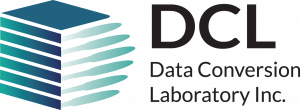
Harmonizer is a powerful tool created by Data Conversion Laboratory that analyzes large document collections to identify content reuse across multiple content sets and source formats. Understanding the volume and nature of duplication in content is invaluable to effectively implement a reuse-based content model like DITA or S1000D. Harmonizer dives deeper into content analysis and can evaluate, identify, and report not only on duplication at the paragraph level but also duplication within specific XML elements such as topics, tasks, concepts, etc. Flexibility in the level of comparison is particularly useful for performing periodic health checks on structured content to diagnose reuse issues or other issues that can arise after DITA or S1000D conversion.
This webinar will demonstrate Harmonizer’s role in performing a health check and speak to use cases that are important for any organization who has invested in DITA or S1000D. Christopher Hill, product manager for Harmonizer and structured content expert, will also detail new licensing models for the software that enable self-serve content health checkups that improve documentation workflows and ensure your investment in markup continues to return healthy results.
Presented by: Christopher Hill, Technical Product and Project Manager at Data Conversion Laboratory – chill@dclab.com
Christopher Hill has 18 years of experience working in publishing and content management. He started his career as a high school teacher but moved into the world of corporate training teaching a range of software and XML courses. He has written and conducted many training courses, was a founding employee of one of the first hosted content management systems and lead the user experience redesign for an enterprise CMS. He now manages the Harmonizer product for Data Conversion Laboratory.
Christopher Hill, Technical Product and Project Manager at Data Conversion Laboratory – chill@dclab.com
Christopher Hill has 18 years of experience working in publishing and content management. He started his career as a high school teacher but moved into the world of corporate training teaching a range of software and XML courses. He has written and conducted many training courses, was a founding employee of one of the first hosted content management systems and lead the user experience redesign for an enterprise CMS. He now manages the Harmonizer product for Data Conversion Laboratory.
-
Recorded: September 7, 2022
 Do you know:
Do you know:
- Which publishing format is still the most popular among technical writers globally?
- Which major content development challenges have been ranked at the top by technical writers?
- Which authoring and publishing tools are the most popular among technical writers?
- Most preferred authoring methods
- Benefits of adopting XML and DITA-based authoring (structured authoring)
- Most popular tools for authoring and publishing technical content
- Top challenges faced while creating and publishing technical content
- Key metrics that define success for technical content
- Challenges with effective content reuse
- Emerging trends in the technical communication industry
 Stefan Gentz is the Senior Worldwide Evangelist for Technical Communication at Adobe, headquartered in San Jose, California, USA. Stefan’s mission is to inspire enterprises and technical writers around the world and show how to create compelling technical communication content with the Adobe Technical Communication tools. He is also a certified Quality Management Professional (TÜV), ISO 9001 / EN 15038 auditor, ISO 31000 Risk Management expert, and Six Sigma Champion.
As a sought-after keynote speaker and moderator at conferences around the world, he travels around the globe half of the year. Besides that, he has been the European Ambassador for the Globalization and Localization Association (GALA) for many years, a member of the tekom Conference Advisory Board for several years, and a founding member of the tekom iiRDS working group for Intelligent Information and member of the OASIS DITA Adoption Committee. In 2016, Stefan Gentz was awarded by MindTouch as one of the Top 25 Leading Content Strategist Influencers in the world and as one of the Top 25 Content Experience Influencers in the world in 2017. Stefan is also the mastermind behind Adobe DITAWORLD, the world’s biggest DITA Online Conference for Marketing and Technical Communication Professionals.
Stefan Gentz on LinkedIn
https://www.adobe.com/products/one-adobe-solution-for-technical-content.html
Stefan Gentz is the Senior Worldwide Evangelist for Technical Communication at Adobe, headquartered in San Jose, California, USA. Stefan’s mission is to inspire enterprises and technical writers around the world and show how to create compelling technical communication content with the Adobe Technical Communication tools. He is also a certified Quality Management Professional (TÜV), ISO 9001 / EN 15038 auditor, ISO 31000 Risk Management expert, and Six Sigma Champion.
As a sought-after keynote speaker and moderator at conferences around the world, he travels around the globe half of the year. Besides that, he has been the European Ambassador for the Globalization and Localization Association (GALA) for many years, a member of the tekom Conference Advisory Board for several years, and a founding member of the tekom iiRDS working group for Intelligent Information and member of the OASIS DITA Adoption Committee. In 2016, Stefan Gentz was awarded by MindTouch as one of the Top 25 Leading Content Strategist Influencers in the world and as one of the Top 25 Content Experience Influencers in the world in 2017. Stefan is also the mastermind behind Adobe DITAWORLD, the world’s biggest DITA Online Conference for Marketing and Technical Communication Professionals.
Stefan Gentz on LinkedIn
https://www.adobe.com/products/one-adobe-solution-for-technical-content.html
 Saibal Bhattacharjee has been with Adobe for more than 12 years now and is currently working as Director of Product Marketing & Business Strategy in the Digital Advertising, Learning & Publishing business unit.
Saibal is in charge of GTM and Business Strategy for a $140MN+ product portfolio in Adobe – ranging from market-leading cloud-native component content management system (CCMS), advertising & subscription monetization products for connected multiscreen TV platforms, content authoring, and publishing desktop apps, to print & scan solutions that power Office and Commercial printers, etc.
Saibal drives the products’ positioning and messaging, brand strategy and communications, marketing campaigns and demand generation (growth and retention), partner ecosystem and new market development, customer education, business insights, market research, and analyst relations, sales enablement, and field marketing efforts.
LinkedIn: https://www.linkedin.com/in/saibalbhattacharjee1979/
Twitter: https://twitter.com/saibalb79
.
Saibal Bhattacharjee has been with Adobe for more than 12 years now and is currently working as Director of Product Marketing & Business Strategy in the Digital Advertising, Learning & Publishing business unit.
Saibal is in charge of GTM and Business Strategy for a $140MN+ product portfolio in Adobe – ranging from market-leading cloud-native component content management system (CCMS), advertising & subscription monetization products for connected multiscreen TV platforms, content authoring, and publishing desktop apps, to print & scan solutions that power Office and Commercial printers, etc.
Saibal drives the products’ positioning and messaging, brand strategy and communications, marketing campaigns and demand generation (growth and retention), partner ecosystem and new market development, customer education, business insights, market research, and analyst relations, sales enablement, and field marketing efforts.
LinkedIn: https://www.linkedin.com/in/saibalbhattacharjee1979/
Twitter: https://twitter.com/saibalb79
. -
Recorded on September 15, 2022

3D has become indispensable in engineering departments. But 3D models rarely find their way into technical documentation. In spare parts catalogs, 3D catalogs have become standard thanks to automatic processing. There, people appreciate that 3D views are intuitively understandable and offer additional interactivity in online documentation. What can technical authors learn from the 3D experiences of the spare parts catalog world?
What steps are necessary in a CCMS to not only visually enhance online documentation with interactive 3D data, but also to enable new access to information? Which formats and tools can be used?
Presented by:
Sebastian Göttel is Head of Marketing and Product Management at Quanos Content Solutions GmbH. The computer scientist has been involved with XML editing systems and content delivery since 1998. In the Tekom environment, he worked on version 1.0 of the iiRDS standard. sebastian.goettel@quanos-solutions.com
Hermann Arya is a digital professional with 15+ years of experience in the aftersales project environment. In Europe he was and still is responsible for the revolution and evolution of 3D visualizations in the service information system context. As Head of Professional Service at Quanos Service Solutions GmbH and through the execution of well over 150 customer projects, he has also been able to build up extensive knowledge of the value chain around service information systems. hermann.arya@quanos-solutions.com
-
Recorded on September 8, 2022

Does this sound familiar: there is so much data in your organization, and it is not always clear which sources are up to date and really relevant to business decisions? Terminology can act as the single source of truth, breaking up data silos and providing the same information to every employee. But in order to achieve that, terminology needs to get close to the users and find its way into their systems.
We share how
- to implement the "single source of truth” in terminology work
- to connect your systems, e.g., ERP, CMS, PIM, CAT tools, etc.,
- to distribute the information
- to make this information usable for all
Join us for a tour that starts with your relevant data sources and ends with a clear and concise terminology process as a way of making sense and use of this data.
Presented by Christian Lang Christian Lang, Technical Consultant, has a wide range of experience and interests in the language field, proven by his degree in Japanese studies and translation. He first became involved with terminology management as a freelance translator for the European Patent Office. Since then, it has become one of his hobbies, as has research in the field of NLP on topics such as machine translation, automatic term extraction, and concept maps.
Christian Lang, Technical Consultant, has a wide range of experience and interests in the language field, proven by his degree in Japanese studies and translation. He first became involved with terminology management as a freelance translator for the European Patent Office. Since then, it has become one of his hobbies, as has research in the field of NLP on topics such as machine translation, automatic term extraction, and concept maps.

